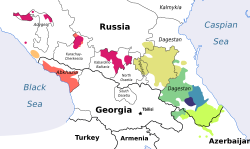Karata-Tukita language
You can help expand this article with text translated from the corresponding article in Russian. (February 2024) Click [show] for important translation instructions.
|
It has been suggested that portions of this article be split out into another article titled Tukita language. (Discuss) (August 2024) |
| Karata | |
|---|---|
| К̄ӀирлӀе мац̄Ӏи k’ːirƛi mic’ːi | |
| Pronunciation | [k’ːirt͡ɬi mits’ːi] |
| Native to | North Caucasus |
| Region | Southern Dagestan |
| Ethnicity | Karata |
Native speakers | 9,549 (2020 census)[1] |
Northeast Caucasian
| |
| Language codes | |
| ISO 639-3 | kpt |
| Glottolog | kara1474 |
| ELP | Karata |
 Karata | |
 Karata is classified as Definitely Endangered by the UNESCO Atlas of the World's Languages in Danger (2010) | |
Karata (кӏкӏирлӏи) is an Andic language of the Northeast Caucasian language family spoken in southern Dagestan, Russia by 9,549 Karata in 2020. There are ten towns in which the language is traditionally spoken: Karata, Anchix, Tukita, Rachabalda, Lower Inxelo, Mashtada, Archo, Chabakovo, Racitl, and formerly Siux.[2] Speakers use Avar as their literary language.[3]
Dialects
[edit]The language has two dialects, Karata and Tukita, which slightly differ in phonetics and morphology but are mutually intelligible.[4] Tukita is sometimes considered a separate language, on the basis of lexicostatistics.[5][6] There are also four subdialects; Anchikh, Archi, Ratsitl and Rachabalda, named after their respective villages.[4]
Phonology
[edit]Consonants
[edit]Karata has 45 consonants.[7]
| Labial | Dental | Alveolar | Palatal | Velar | Uvular | Pharyn- geal | Glottal | ||||||||
|---|---|---|---|---|---|---|---|---|---|---|---|---|---|---|---|
| central | lateral | ||||||||||||||
| lenis | fortis | lenis | fortis | lenis | fortis | lenis | fortis | lenis | fortis | ||||||
| Nasal | m | n | |||||||||||||
| Plosive | voiced | b | d | ɡ | |||||||||||
| voiceless | p | t | k | ʔ | |||||||||||
| ejective | (pʼ) | tʼ | kʼ | ||||||||||||
| Affricate | voiced | (d͡ʒ) | |||||||||||||
| voiceless | t͡s | t͡sː | t͡ʃ | t͡ʃː | t͡ɬː | k͡xː | q͡χː | ||||||||
| ejective | t͡sʼ | t͡sʼː | t͡ʃʼ | t͡ʃʼː | t͡ɬʼ | t͡ɬʼː | k͡xʼː | q͡χʼː | |||||||
| Fricative | voiceless | s | sː | ʃ | ʃː | ɬ | ɬː | ç | x | xː | ʜ | h | |||
| voiced | v | z | ʒ | ɣ | ʢ | ||||||||||
| Trill | r | ||||||||||||||
| Approximant | l | j | |||||||||||||
- The glottal stop transcribed here is named rather ambiguously a "glottalic laryngeal" by the source.
Vowels
[edit]Karata has 18 vowels.[7]
References
[edit]- ^ Том 5. «Национальный состав и владение языками». Таблица 7. Население наиболее многочисленных национальностей по родному языку
- ^ Nichols, Johanna (2006). "Review: Karatinsko-russkij slovar' [Karata-Russian Dictionary]". Anthropological Linguistics. 48 (1): 95–98. ISSN 0003-5483.
- ^ Lewis, M. Paul; Gary F. Simons; Charles D. Fennig, eds. (2015). Ethnologue: Languages of the World (18th ed.). Dallas, Texas: SIL International.
- ^ a b "The Karatas". www.eki.ee. The Red Book of the Peoples of the Russian Empire. Retrieved 2021-06-07.
- ^ Atlas of the World's Languages in Danger (Report) (3rd ed.). UNESCO. 2010. p. 42.
- ^ "Тукитинский язык | Minority languages of Russia". minlang.iling-ran.ru. Retrieved 2024-09-27.
- ^ a b "Каратинский язык | Minority languages of Russia". minlang.iling-ran.ru. Retrieved 2024-10-01.
- ^ Consonant Systems of the North-East Caucasian Languages on TITUS DIDACTICA
- ^ Sudaba Zeynalova. Ethnodemographic Changes in the Caucasus: Development of Ethnic European Communities in the Late Nineteenth and Early Twentieth Century Archived 2016-03-05 at the Wayback Machine. Central Asia & Central Caucasus Press AB, 2009, No. 4.


 French
French Deutsch
Deutsch
